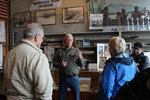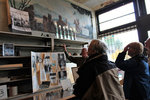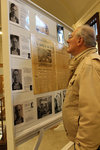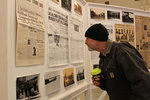



“We don’t talk about it.”
That’s the typical answer local historians say they get when they ask people about the 1919 Centralia Armistice Day Tragedy.
Even 100 years after it happened, it remains a sore spot for many. But there are a few voices fighting to not just keep the history alive but possibly shed new light on the incident. They took the opportunity of the 100th anniversary of the tragedy to invite the public to learn more about the controversial subject.
“It shouldn’t be forgotten,” said Lewis County Historical Museum Director Jason Mattson. “It shouldn’t be swept under the rug and I think for the longest time that was what people wanted to do about it. That’s not how history should be treated.”
The Lewis County Historical Museum in Chehalis hosted a special exhibit over the weekend marking the 100th anniversary of the Armistice Day Tragedy. At the same time, in Centralia, a pop-up museum, at the property on Tower Avenue owned by the Lewis County Historical Society, also displayed artifacts from the incident. They were just two of many activities over the weekend commemorating the 100th anniversary of the Armistice Day Tragedy, Armistice Day and the founding of the Grand Hodges American Legion Post.
The special exhibit at the Lewis County Historical Museum, which is open through Nov. 16, exhibited many never-before-seen artifacts from the incident that were part of a large, anonymous donation to the museum more than a year ago. Some of the donated items include court records and original photos used in the court case against the International Workers of the World members. Mattson said it was fascinating work to go through some of these historical treasures and in presenting them, they took great care to be sensitive to the controversial nature of the items.
“We did our best to not be opinionated, to present the facts or show what history perceived it as being,” Mattson said.
In addition to some of the World War I items already on display at the Centralia Lewis County Historical Society site, the pop-up museum also included some of the artifacts from the anonymous donation. Society president Peter Lahmann said the effort to commemorate the 100th anniversary of the tragedy has had its own controversy because of the wide array of beliefs about what actually occurred on Nov. 11, 1919. While the two sides often don’t seem any closer to reaching an agreement, Lahmann said he prefers to see all of the historical evidence as having value.
Pacific Northwest Labor History Association president Tom Lux said it is important to understand that the Centralia incident was just one of many in the state and around the nation at that time. He said 1919 was a very active year for the labor movement and with that activity came many skirmishes regarding labor issues, including a city-wide strike in Seattle where “nothing moved but the tides” and an incident on the Everett waterfront that, like Centralia, turned deadly.
“There were a lot of intense feelings from 1919 on so it’s a significant event in our history,” Tom Lux said of the Centralia Tragedy. “Those struggles based on the ideology of the time are still going on today.”
It is precisely that historical significance that motivates Lahmann to continue to push conversations about the Armistice Day Tragedy forward. He said it is a subject taught in labor history classes at every university yet when he has asked local people about the 1919 incident, their response is most often “we don’t talk about it.”
“I just enjoy history and I want it to be as correct as possible,” Lahmann said.
State Senator Karen Keiser, chair of the Senate Labor Committee, visited the Lewis County Historical Museum, Pop-Up Museum and several other sites involved with the tragedy as part of a group representing the Pacific Northwest Labor History Association. She said the controversy regarding the Centralia Tragedy reminds her of a recent trip to Germany, where she saw myriad memorials dedicated to different parts of World War II and the Holocaust. She said some of the markers were very small and subtle, but they send a large message.
“They don’t want to forget,” Keiser said. “I think that’s so important. I think we don’t do that in this country. We let ourselves forget what happened to (groups such as) the Indians or the slaves but if you forget or don’t really acknowledge an incident that’s not a great place to be. We need to understand we have a really terrific history but it has some stains.”
History, even the less pleasant or comfortable parts of it, is worth preserving for the sake of not repeating it noted Ron McGaha, a Pacific Northwest Labor History Association trustee. And it is the controversy of the subject of the Armistice Day Tragedy that makes it especially important, he added.
“It’s kind of like a piece of art,” McGaha said. “The best art is controversial and it sparks discussion.